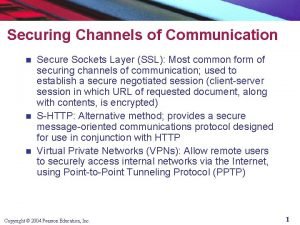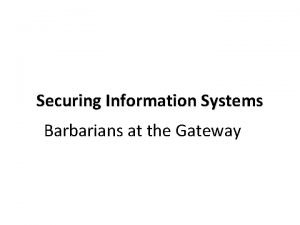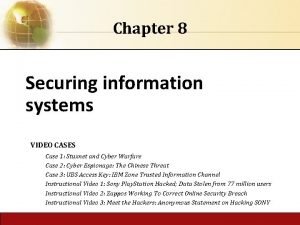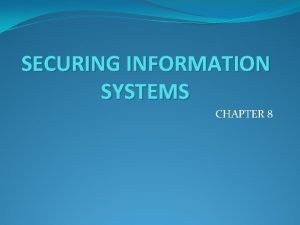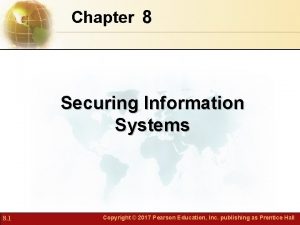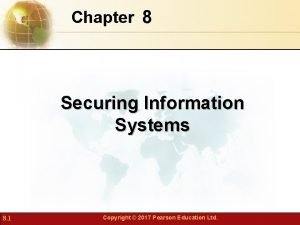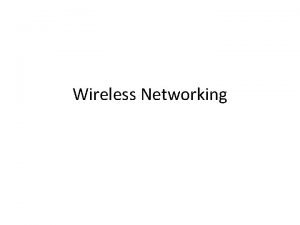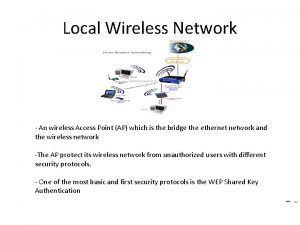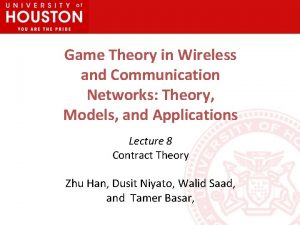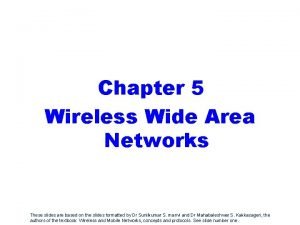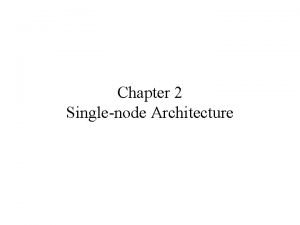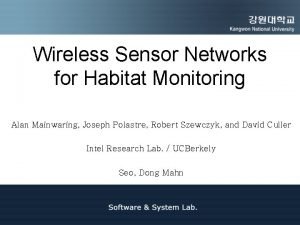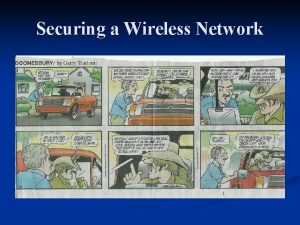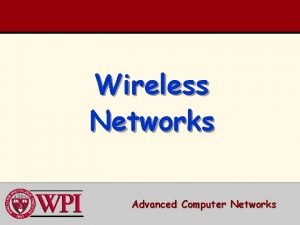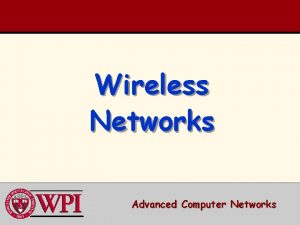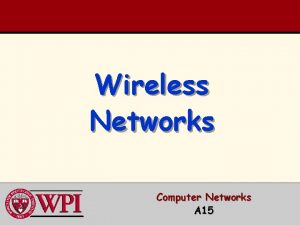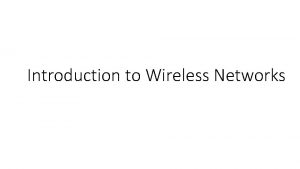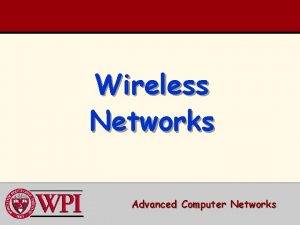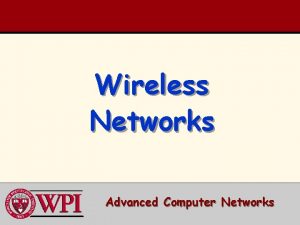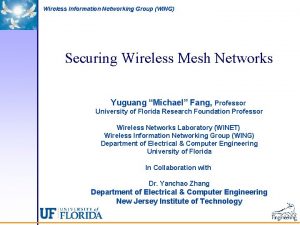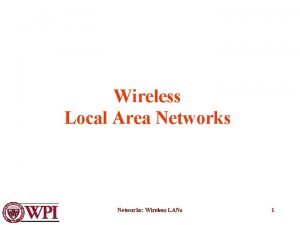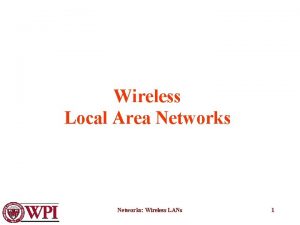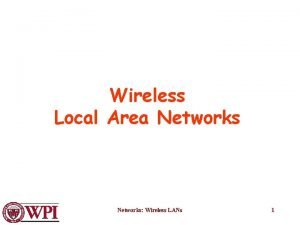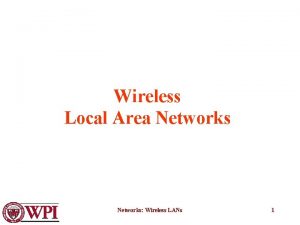Securing Information through Trust Management in Wireless Networks
















- Slides: 16

◊ Securing Information through Trust Management in Wireless Networks Mohit Virendra, Shambhu Upadhyaya Computer Science and Engineering The State University of New York at Buffalo, NY Sep 24, 2004 1

Trust Schemes: Wireless Domain Wireless Network Classification 1. Independent Ad-hoc 2. Central Authority Trust-based Security Schemes a. Independently Mutual information exchange between the nodes b. Using a Trusted Central Authority CEISARE @ 2

Overview Problem Statement: Defining trust schemes for securing information in WLANs and Ad-hoc networks Contributions: Trust based Admission Control scheme with a first yes policy for WLANs Trust monitoring through Intent Graphs in wireless domain Actual Condition Review-based Peer Monitoring Scheme Trust based security scheme for ad-hoc networks: Physical and Logical Security Domains Trust management through Domain Heads in ad-hoc networks CEISARE @ 3

CA Assisted Scenario: WLAN model WLAN Architecture: Two servers on the Distribution System: (a) Admission Controller (AC), (b) Global Monitor (GM) Trust Based Admission Control admission time trust establishment Admission decision depends on “trust value” and “intent” of the new node Intent query scheme between AC and the new node Perfunctory check policy for node with unknown trust Optimistic Approach: Trust everyone until misbehavior detected “First Yes Policy”: Node proves and maintains trust value to be in session. Trust verified while node is in the system Looks Naïve! But very effective in selective admission control CEISARE @ 4

WLAN model: Trust Establishment Nodes use symmetric key pairs for communication with AP, key duration dependent on trust value and “incrementing” trust also Trust Levels: Used to (dis)allow a node to perform certain operations Intent Map (Graph) Generation: models node’s intended behavior Three Trust Levels: Low, Medium and High FSM based on resources required & steps to be followed During the operation, AC/GM monitors node using GHMS [10], checks against Intent Map and builds its Trust History Benign transactions increase node’s trust value Relationship between transactions completed and trust value depicted by graph on next slide CEISARE @ 5

High (Malicious) Trust Value vs. Operations Medium Low/ Unknown Operations (Benign) Misbehavior Threshold (Intrusion Flagged)

Intent Graphs and ACR generation Tolerance in Intent Graphs Tolerance Level and Misbehavior Threshold Dealing with excess data rates: calculating threshold as an incremental percentage or probability as a function of data rates [11] Each deviation => closer to threshold ~ severity of misbehavior Flagging an intrusion == premature expiration of the session key between node and AP Trust Values help in Leader Selection Peer Trust Monitoring: Actual Condition Review (ACR) report generation scheme FORWARD MONITORING: APs generate ACRs about nodes REVERSE MONITORING: Nodes generate ACRs about APs SELF MONITORING: Nodes forced to submit their own progress report Result: A self correcting trust monitoring system CEISARE @ 7

WLAN Logical Implementation

Independent Ad-hoc Networks Mutual Information Exchange Based Trust Based Domains Grouping nodes with similar trust parameters and interests Defining Qualitative Trust Parameters and Quantifying Trust A ~> B and B ~> C, then A =~> C using B’s trust as a verifier More comprehensive schemes if A and C don’t trust a common node Node may share trust interests with nodes belonging to two or more domains: “Border Nodes” Membership in a domain a collective decision (e. g. secure polling) Encryption Schemes proposed by Zhou et al. [17], [18] CEISARE @ 9

Domains Nodes preloaded with keying material: establish pair-wise symmetric keys on the fly with domain members Nodes in a Domain share a common DOMAIN KEY Domain Heads: Election and Rotation Domain Heads can establish pair-wise symmetric keys with each other on the fly for trust negotiation All inter and intra-domain communication uses symmetric pair-wise keys Physical Trust Domains (PTDs) and Logical Trust Domains (LTDs) Overlapping PTDs Overlapping LTDs Non-overlapping PTDs Non-overlapping LTDs CEISARE @ 10

Overlapping PTDs PTD A Na PTD B Nab CEISARE @ PTD C Nbc Nc 11

Overlapping PTDs CEISARE @ 12

Non Trusted Regions and Hierarchical Trust Communication between non-trusted regions: End to end tunnels Tradeoff between: Information Security and Information Relevance Lifetime Sending information along multiple routes: Minimum Trust Value of a route Hierarchical Trust and Super Domains Addressing Scalability and Reduce Control Overhead of Head Nodes Hierarchical Trust : Would help if a domain head (hence all domain members) are compromised But, requires extra degree of protection for domain heads and super domain heads against attacks targeted at Central Authority CEISARE @ 13

Conclusion and Discussion Introduced trust based schemes for wireless networks Trust based security model for WLANs Idea of Physical and Logical Trust Domains in ad-hoc networks Conceptual paper: describes new paradigms and concepts, require deeper investigation Continuing Research: Studying control overheads of the schemes introduced by us Formalizing the “first yes” admission control scheme Extending the ACR generation scheme to ad-hoc networks CEISARE @ 14

References 1. 2. 3. 4. 5. 6. 7. 8. 9. 10. 11. 12. 13. 14. 15. 16. 17. 18. 19. A. Rahman and S. Hailes, “A Distributed Trust Model”, New Security Paradigms Workshop 1997, ACM, 1997. D. Balfanz, D. Smetters, P. Stewart and H. Wong, “Talking to Strangers: Authentication in Ad-hoc Wireless Networks”, NDSS, San Diego, 2002. L. Eschenauer, V. Gligor and J. Baras, “On Trust Establishment in Mobile Ad-Hoc Networks”, Proc. 10 th International Workshop of Security Protocols, Springer Lecture Notes in Computer Science (LNCS), Apr. 2002. J. Kong, H. Luo, K. Xu, D. L. Gu, M. Gerla, and S. Lu, “Adaptive security for multi-layer ad-hoc networks, ” in Special Issue of Wireless Communications and Mobile Computing. Wiley Interscience Press, Aug. 2002. T. Hughes, J. Denny, P. Muckelbauer, J. Etzl, "Dynamic Trust Applied to Ad Hoc Network Resources", Autonomous Agents & Multi-Agent Systems Conference, Melbourne, Australia, 2003. J. Kong, P. Zerfos, H. Luo, S. Lu and L. Zhang, “Providing Robust and Ubiquitous Security Support for Mobile Ad-hoc Networks”, ICNP, Riverside, CA, 2001. L. Zhou and Z. J. Haas, “Securing ad hoc networks, ” IEEE Network Magazine, vol. 13, no. 6, pp. 24– 30, Nov. ’ 99. C. Davis, "A localized trust management scheme for ad-hoc networks", Proc. 3 rd International Conference on Networking (ICN'04), Mar. 2004. H. Debar, M. Dacier, A. Wespi and S. Lampart, “An Experimentation Workbench for Intrusion Detection Systems”, Research Report, IBM Research Division, Zurich Research Laboratory, Switzerland, 1982. M. Virendra, S. Upadhyaya, X. Wang, “ GSWLAN: A New Architecture Model for a Generic and Secure Wireless LAN System”, 5 th Annual IEEE Information Assurance Workshop, West Point, NY, June 2004. M. Molloy, “Performance analysis using Stochastic Petri Nets”, IEEE Trans. On Computers, vol. 39, no 9, pp. 913 -917. Y. Huang and W. Lee, “A Cooperative Intrusion Detection System for Ad Hoc Networks”, ACM CCS SASN Worskhop, Oct. 2003. Y. Huang, W. Fan, W. Lee, and P. Yu, “Cross-feature analysis for detecting ad-hoc routing anomalies”, 23 rd International Conference on Distributed Computing Systems, Providence, May 2003. S. Upadhyaya, R. Chinchani, K. Kwiat, "An Analytical Framework for Reasoning about Intrusions", Symposium on Reliable Distributed Systems (SRDS’ 01), New Orleans, Oct. 2001 L. Zhou, F. Schneider, R. van Renesse, “COCA: A secure distributed on-line certification authority”, ACM Transactions on Computer Systems 20, Nov. 2002, pp. 329– 368. H. Debar, M. Dacier, A. Wespi, S. Lampart, “An Experimentation Workbench for Intrusion Detection Systems”, Research Report, IBM Research Division, Zurich Research Laboratory, Switzerland, 1982. S. Zhu, S. Xu, S. Setia and S. Jajodia, “Establishing Pair-wise Keys for Secure Communication in Ad Hoc Networks”, 11 th IEEE International Conference on Network Protocols (ICNP’ 03), Atlanta, Nov. 2003. S. Zhu, S. Xu, S. Setia, S. Jajodia and P. Ning, “An Interleaved Hop-by-Hop Authentication Scheme for Filtering of Injected False Data in Sensor Networks”, IEEE Symposium on Security and Privacy, Oakland, May 2004 Y. Ko , N. Vaidya, “Location-aided routing (LAR) in mobile ad hoc networks”, Proc. 4 th annual ACM/IEEE international conference on Mobile computing and networking, pp. 66 -75, Dallas, Oct. 1998 CEISARE @ 15

Questions ? Email: {virendra, shambhu}@cse. buffalo. edu www. cse. buffalo. edu/~virendra 16
 The most common form of securing channels is through
The most common form of securing channels is through Telecommunications the internet and wireless technology
Telecommunications the internet and wireless technology Securing information systems
Securing information systems Securing information systems
Securing information systems Securing information systems
Securing information systems Chapter 8 securing information systems
Chapter 8 securing information systems An information systems examines a firm's overall security
An information systems examines a firm's overall security Chapter 8 securing information systems
Chapter 8 securing information systems Chapter 8 securing information systems
Chapter 8 securing information systems Wireless networking definition
Wireless networking definition Local wireless networks
Local wireless networks Game theory in wireless and communication networks
Game theory in wireless and communication networks Wireless wide area network
Wireless wide area network Single node architecture in wsn
Single node architecture in wsn Wireless sensor networks for habitat monitoring
Wireless sensor networks for habitat monitoring Wired and wireless media
Wired and wireless media Wireless networks
Wireless networks
